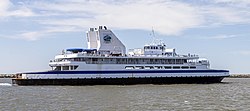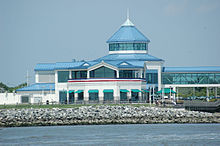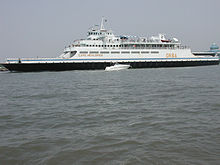Cape May–Lewes Ferry
 M.V. Delaware near the Lewes, Delaware terminal on May 21, 2019 | |
| Locale | |
|---|---|
| Waterway | Delaware Bay |
| Transit type | Passenger/automobile ferry |
| Owner | Delaware River and Bay Authority |
| Operator | Delaware River and Bay Authority |
| Began operation | July 1, 1964 |
| System length | 17 miles (27 km) |
| No. of lines | 1 |
| No. of vessels | 3 |
| No. of terminals | 2 |
| Website | http://www.cmlf.com/ |
The Cape May–Lewes Ferry is a ferry system in the United States that traverses a 17-mile (27 km) crossing of the Delaware Bay to connect North Cape May, New Jersey with Lewes, Delaware. The ferry constitutes a portion of U.S. Route 9, and is the final crossing of the Delaware River-Delaware Bay waterway before it meets the Atlantic Ocean.
System[]

The Cape May–Lewes Ferry, operated by the Delaware River and Bay Authority (DRBA), consists of three ferry vessels and two terminal facilities. Its operations are based at its Cape May terminal, which is actually located in North Cape May, on the north shore of the Cape May Canal.
The three vessels in the fleet carry both vehicles (passenger cars, buses, RVs, tractor trailers, motorcycles, and bicycles) and foot passengers. Each has a capacity of about 100 cars, selling out in advance during the popular summer weekends (although passenger capacity usually does not). Advance reservations are accepted.
The ferry trip takes approximately 85 minutes. The company's site says that the roundtrip is approximately three hours.[1] and provides a view of three lighthouses: the Cape May Light in New Jersey, and the Harbor of Refuge Light and Delaware Breakwater East End Light near Lewes.

The ferry's terminal buildings were substantially overhauled in 2000–01. A new Cape May terminal replaced the existing structure, built in 1988. The Lewes terminal, also built in 1988, was expanded and renovated at the same time. Both terminals now feature unique, recognizable "towers," which contain elevators and staircases connecting the terminal buildings to glass-enclosed walkways. The walkways allow foot passengers to board the vessel directly on the second deck, avoiding vehicles driving onto the car deck below.
The terminal buildings feature gift shops, food courts, bars, restaurants, ticketing and information booths, and occasional history or art exhibits.
Fleet[]
The original fleet of four steamships and two diesel-powered ships was purchased in 1964 from the defunct Little Creek-Cape Charles Ferry in Virginia, replaced by the Chesapeake Bay Bridge–Tunnel. Those ships were the SS Cape May (originally the SS Delmarva 1934), the SS Delaware (originally the SS Pocahontas 1941), the SS New Jersey (originally the SS Princess Anne 1936), the MV Cape Henlopen (originally the SS Virginia Beach and USS (Buncombe County) LST-510) and later in 1964, the MV Atlantic (originally the MV Old Point Comfort converted from USS LST-970) (this vessel was sold at the end of 1966).[2] The four remaining ships were replaced beginning in 1974 with new, diesel-powered vessels. The three original vessels of the new fleet, the MV Delaware, MV New Jersey, and MV Twin Capes, were supplemented by the MV Cape Henlopen (originally named New Del) in 1981 and the MV Cape May in 1985. Although these five vessels would later differ in external appearance, they were originally designed and built to identical specifications. Renovation projects in the mid- to late-1990s radically altered the shapes and appearances of the fleet. However, the vessels were only rebuilt from the hull up, meaning that their hulls and power plant remain identical.
Each vessel consists of an open car deck situated atop a hull that is low to the water. Because of the ships' shallow displacements, the ships appear almost barge-like, sitting directly atop the water, from a distance. The ships were originally built with two decks atop the car deck—the second deck consisting of a gift shop, café, and interior and exterior seating areas, and the third deck consisting of outdoor seating areas. Historically, an interior crew room was situated on the third deck, and a pilot house was on the fourth deck. Subsequent renovations changed these plans on some of the vessels.
Each vessel can hold 100 cars and 800 passengers. All have a length of 320 feet (98 m) and a breadth of 68 feet (21 m), a displacement of at least 2,100 tons, a maximum draft of 7 feet (2.1 m), two 4,000 horsepower (3,000 kW) diesel engines, and a top speed of 16 knots (30 km/h) (18 mph).[2]
MV Delaware[]

The MV Delaware was the first of the original three vessels of the new 1970s fleet. Christened in June 1974 she is the flagship of the fleet. The Delaware has undergone several renovations and refurbishments. The first in 1994 added an additional passenger lounge on the third deck which included a deli and an outdoor bar with refurbishments to her main passenger lounge on the second deck. New "shark fin" smokestacks were added in 1997 replacing her original stacks. A renovation in 2001 resulted in her second and third decks being extended forward and aft and the outdoor bar moved behind the stacks along with renovations to both interior spaces. A third renovation in 2013 reconfigured the interior space on the second deck.
MV New Jersey[]
The MV New Jersey is the second of the original three vessels of the new 1970s fleet, christened in November 1974. An outdoor canopy was added to the third deck in 1996 and in 1999 she received upgraded finishes and seating to the interior passenger lounge. Her main passenger lounge was recently renovated in 2013 with new carpeting and seating.
MV Twin Capes[]

The MV Twin Capes is one of the original three vessels of the 1970s fleet, christened in May 1975. She was extensively renovated in a $27 million project between 1994 and 1996 resulting in the original superstructure on and above the second deck removed, the second deck extended forward and aft, and a new superstructure with four new decks, multiple lounges, new pilot house and "shark fin" smokestacks added. The vessel was then marked as a miniature cruise ship, complete with two sets of elevators, a sweeping interior staircase, interior areas on four different decks, an enlarged retail shop, a food court with a brick pizza oven, four different bars, and a buffet restaurant in a two-deck-tall, glass-enclosed atrium. Although the restaurant was shut down in 2000 after U.S. Food and Drug Administration inspectors found numerous violations in the galleys of all five vessels, the ship remained an attraction. Her sister ship is the MV Delaware. In July 2010, due to decreasing ridership, the DRBA announced that the vessel was for sale.[3] The Twin Capes was taken out of service and retired in October 2013. On July 20, 2017, the Twin Capes was towed out of the Cape May Terminal to be stripped before a planned sinking as an artificial reef in 2018 in a project lead by Captain Tim Mullane.[4] The Twin Capes was scuttled on June 15, 2018, in the North Atlantic Ocean off Bethany Beach, Delaware, at 38°30.90′N 074°30.90′W / 38.51500°N 74.51500°W to form part of the Del-Jersey-Land Inshore Artificial Reef.[5][6]
MV Cape Henlopen[]

The MV Cape Henlopen, the fourth vessel of the fleet built in 1981 was christened New Del in July 1981. The vessel was renamed Cape Henlopen in 1984. She received new outdoor seating and a canopy along with new indoor seating in 1998. A more recent refurbishment in 2012 resulted in new interior lighting, flooring, seating and climate control.
MV Cape May[]

The MV Cape May, which was the newest vessel of the fleet christened in May 1985, was refurbished in 1998 in a $20 million project that retained the original superstructure and added deck extensions and a new fourth deck. The renovation added a fourth-deck buffet restaurant, bars, an enlarged gift shop, an elevator, and additional interior seating. In 2007, in order to help close an operating deficit, the DRBA removed the Cape May from service and announced that the vessel was up for sale. The vessel's added expense of operation and low use—it had made only fifteen crossings in 2007—were additional factors leading to its removal from service.[7] The owners of Cross Sound Ferry in Connecticut had shown interest in purchasing the ferry. In 2013, the Cape May was sold to Northstar Marine Services for $750,000, to be converted to a support vessel for offshore wind farms.[8]
History[]
Service began on July 1, 1964, utilizing a fleet of five ships purchased from Virginia as mentioned above. Those ships had previously provided service across the Chesapeake Bay, connecting Cape Charles with Virginia Beach, but the opening of the Chesapeake Bay Bridge–Tunnel in 1964 rendered that service obsolete. All of the steamers were replaced in the 1970s with the service's current fleet.
When it began service, the Cape May–Lewes Ferry operated under a 24-hour schedule. That schedule was cut back in 1975 to 16 hours per day.[9]
The Cape May-Lewes Ferry welcomed its first female permanent captain, Sharon Urban, in August 2020.[10]
Tourism[]

The ferry was constructed with transportation as its chief goal. However, over time, the Delaware River and Bay Authority (DRBA) began to recognize its potential as a tourist attraction. While the ferry of today continues to provide a vital transportation link between Delaware and New Jersey, the ferry experience has been optimized to draw in tourists.
The ferry fleet was substantially overhauled during the 1990s, adding several amenities—including buffet restaurants, bars, and lounges—intended to promote the ride as a draw in itself. The DRBA operates a shuttle service on both sides of the bay in the summer months, giving foot passengers both a ride on the ferry and round-trip transportation from the terminals into Cape May and Lewes for one combined rate. In New Jersey, the shuttle connects the ferry to the Cape May Welcome Center in downtown Cape May. In Delaware, the shuttle operates from the ferry to the Tanger Outlets and the park and ride lot in Rehoboth Beach. DART First State operates the Route 204 bus which connects the ferry terminal with downtown Lewes and the Lewes Transit Center park and ride, where transfers can be made to DART First State's Beach Bus routes that serve the Delaware Beaches and provide connections to Ocean City Transportation's Coastal Highway Beach Bus in Ocean City, Maryland.[11] The DRBA also operates a shuttle bus that links the ferry to the Cape May County Park & Zoo on Tuesdays, Thursdays, and Sundays from late June to the end of August and to the Tree to Tree Aerial adventure park at the zoo Sundays through Thursdays from late May to late September. The Mid-Atlantic Center for the Arts operates trolley tours of Cape May from the ferry terminal from late June to the end of August, with the Cape May Lighthouse tour operating on Mondays and the Emlen Physick Estate tour operating on Wednesdays. On Wednesdays from June to September, Lucky Sevens Tours operates a coach bus that connects the ferry in Cape May to the Resorts Casino Hotel in Atlantic City; the package includes round-trip ferry service, round-trip coach service, and free play for slots.[12] The DRBA has partnered with local merchants to give discounts to passengers, allowing passengers to purchase a round-trip ticket and not disembark midway.
In addition to these promotions, the ferry also offers special holiday excursions. A popular, but expensive, excursion includes the annual fireworks cruise, in which passengers board the vessel and sail into the bay to watch a Fourth of July fireworks show sponsored by the DRBA. The cruise features entertainment on the car deck (past entertainment has included a symphony orchestra) and a catered meal.
The ferry is a connection between the south Jersey Shore towns from Long Beach Island to Cape May, and the Delaware Beaches and Ocean City, Maryland on the Delmarva Peninsula. Prior to its inception, travelers between these areas needed to drive across southern New Jersey to the Delaware Memorial Bridge, and then down through Delaware on U.S. Route 13, or vice versa if they were coming from Delaware.
Incidents and accidents[]
On the evening of December 10, 2009, the New Jersey ran aground on a sandbar near the mouth of the Cape May Canal during an unusually low tide. The ferry was freed by a rising tide and did not suffer any structural damage.[13]
On March 30, 2019, after going three miles from Cape May, New Jersey, the ferry lost power with 143 passengers onboard. After two hours being stuck in the bay the ferry was towed back to Cape May. https://whyy.org/articles/cape-may-lewes-ferry-stranded-for-hours-in-delaware-bay/
On November 17, 2020, after leaving Cape May in high winds, the Cape Henlopen ran aground off the coast of Cape May, New Jersey. The passengers were not harmed and the vessel was towed back to Cape May shortly after.[14]
See also[]
References[]
- ^ Cape May - Lewes Ferry Schedule & Fares, access-date=May 9, 2020 https://www.cmlf.com/schedules-fares}
- ^ Jump up to: a b "A Ferry Tale", by William J. Miller
- ^ "Cape May–Lewes Ferry Puts Second Boat Up For Sale". Cape May County Herald. July 2010.
- ^ "No more people or cars, just fish for Cape May ferry vessel". NJ.com. July 2017.
- ^ Anonymous, "M/V Twin Capes, retired Lewes-to-Cape May ferry, sunk to become part of Delaware’s artificial reef system," delaware.gov, June 15, 2018. Retrieved July 30, 2018
- ^ "Luxurious Twin Capes ferry sunk for artificial reef". Press of Atlantic City. June 15, 2018.
- ^ "DRBA Seeks Buyer for MV Cape May". Cape May County Herald. September 2007.
- ^ Degener, Richard (June 26, 2013). "Cape May-Lewes unused ferry sold at loss to become a barge". Press of Atlantic City. Retrieved August 17, 2013.
- ^ 40th Anniversary 1964–2004, History of Cape May–Lewes Ferry Archived October 26, 2006, at the Wayback Machine
- ^ "Home - Bay to Bay News | Bay to Bay News".
- ^ "Getting Here & Getting Around". Cape May-Lewes Ferry. April 20, 2017. Retrieved June 20, 2017.
- ^ "Excursion Packages". Cape May-Lewes Ferry. Retrieved June 20, 2017.
- ^ Degener, Richard (December 12, 2009). "Ferry runs aground at canal". Press of Atlantic City. Retrieved March 18, 2014.
- ^ "High winds push Cape May Ferry aground with 23 passengers, 9 cars".
External links[]
| Wikimedia Commons has media related to Cape May–Lewes Ferry. |
Coordinates: 38°52′40″N 75°03′44″W / 38.87764°N 75.06226°W
- Ferries of Delaware
- Ferries of New Jersey
- U.S. Route 9
- Crossings of the Delaware River
- Delaware River and Bay Authority facilities
- Lewes, Delaware
- Transportation in Sussex County, Delaware
- Transportation in Cape May County, New Jersey
- Ferries of the United States Numbered Highway System
- Delaware Bay
 WikiMiniAtlas
WikiMiniAtlas